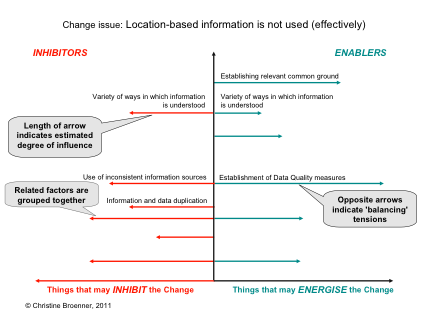Let’s talk about Location - Overcoming the differences in understanding, meaning and realizing the value of location
Adding location to business intelligence isn’t always as easy as it seems. There are basic issues and hidden assumptions about ‘location’ that sometimes lead people off the track. This happens when thinking about how location information can support informed decision-making and improve the provision of services. To incorporate location into business analysis, it is worthwhile considering the following points that are fundamental to the use of location information:
- Location has different levels of meaning. Location information on ‘housing’, for example, can comprise of coordinate grid points, postal addresses, and topographic maps showing various types of built-up areas etc.
- The meaning of location can be significant in different ways:
- Is the location information static or does it represent movement in space?
- Does it reflect dynamics and relationships between objects or non-object based phenomena?
- Is it referring to trends, changing densities and distributions over time?
- The different types of users or communities, with a specific purpose and ethos, like businesses, community groups, government institutions etc. are based on a variety of cultural backgrounds and have differing values.
Exposing differences in the understanding, meaning and significance of location during discussions about the value that location can add to business intelligence, can prevent misunderstandings. These might otherwise inhibit the effective implementation and utilisation of location information. Exploring the differences systematically can also reveal novel possibilities. What emerges from all the discussions can contribute to the formulation of user requirements and the identification of previously untapped options to shape new market opportunities.
The ‘Trade-off space’* is a tool for thought to identify the relationships and interdependencies between different combinations of location understanding in any context. With the help of the tool it is possible to visualise and explore some of the factors and the consequences that such differences may have in practice.
Talking about location might seem simple in some business cases, but can become more challenging in more complex settings such as in county councils, who are responsible for a multitude of daily operations and interventions for the public. Services such as health and social care, waste management, road maintenance, schools and libraries, fire brigades, land and property, environmental protection, markets, town planning, taxation etc. cover a broad range of disciplines and require location information with a variety of meaning or significance attached to ‘location’ features and events.
A county council in the UK, one of the largest local authorities in the country, has embarked on a major efficiency and performance change in its operation. The council envisions managing and sharing all corporate information inside the council and is considering sharing data with external bodies such as central government agencies, utilities and so on. Such a vision raises the need to develop an appreciative understanding of the wider context in which the council’s actions and intervention take place; its possibilities and the roles that the various operating officers and customers play in it. One of the key issues, identified right at the beginning of the project initiated to bring about change, was the ineffective use of location information within the council. Using the ‘Trade-off space’ tool, Inhibitors and possible Enablers are plotted under just that heading ‘Location-based information is not used (effectively)’. The different views on and understanding of the levels and significance of location can thus be revealed:

Appreciation and reflection in this context can achieve a rich picture and common understanding of location amongst the diverse applications within the council environment. It can also assist the development of effective, appropriate and interoperable business solutions. What is important is to understand the variety of ways in which location information can be expressed and used – especially where the ‘sharing’ and interaction with others is clearly part of the council’s vision.
This article was written in conjunction with Christine Broenner, Independent Senior GIS-Expert and co-author of the book quoted in the article.
* The Trade-off space, and many other relevant tools and techniques, are presented in the recently published book Complexity Demystified – A guide for Practitioners by Beautement and Broenner, Triarchy Press, ISBN: 978-1-908009-24-1
